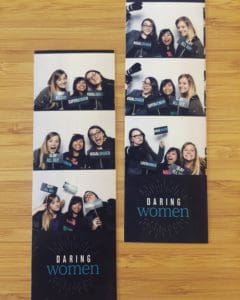As a female owned local business, we had the opportunity to be a part of Seattle Business Magazine’s Daring Women Seattle event last month- a conference where the most fearless females in Seattle came together to talk about the innovation, growth, inspiration, and leadership of their different industries.
The opportunity to be around so many powerful women was truly inspiring and energizing, especially as a female owned and majority operated video production company. We are among the minority of female business owners in the USA, and an even smaller minority in the male dominated world of video production.
Our industry, like many (or probably most) other industries, suffers from a severe lack of female access to the board rooms, writing tables, and most blatantly- behind the camera. This comes from decades of gender roles, Hollywood traditions, and lack of access to the same opportunities- not to mention the Harvey Weinstein’s of the film world. This all may sound like rhetoric, but take the Celluloid Ceiling study– a 20 year long study of Hollywood’s inclusion of women in top grossing films. The study showed that when you consider the top 250 films of 2017, 88% had no women directors, 83% had no women writers, 80% had not women editors, and 96% had no women cinematographers.
To put that into a slightly more depressing historical perspective, in 2017, women comprised of 18% of all directors, writers, producers, editors, and cinematographers- which is a 1% increase from 2016 and is virtually unchanged from the percentage recorded in 1998. These facts shook us as we read them, but fired up an ever familiar flame to break the mold, and dare we say it, tear down that damned Celluloid Ceiling.
As a company operated by women (and one very supportive, allied man), we feel proud to be female pioneers in our industry, and are excited by what we have built, the company that we continue to grow, the relationships with clients we have fostered, and the blossoming portfolio of work that we have tirelessly created.
Though these statistics feel intimidating, we are optimistic about the role of women in the future of the film industry and the role we as a company can play in the normalization of female owned production companies (and producers, editors, cinematographers, and sound recordists). We are elated to see a world where the female perspective is incorporated into creative content creation and one where women are given (or are demanding, rather) a stronger role behind the cameras.
Support your local female filmmakers!

